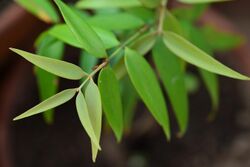Biology:Agathis philippinensis
| Agathis philippinensis | |
|---|---|

| |
| Scientific classification | |
| Kingdom: | Plantae |
| Clade: | Tracheophytes |
| Clade: | Gymnospermae |
| Division: | Pinophyta |
| Class: | Pinopsida |
| Order: | Araucariales |
| Family: | Araucariaceae |
| Genus: | Agathis |
| Species: | A. philippinensis
|
| Binomial name | |
| Agathis philippinensis Warb.
| |
Agathis philippinensis (in Tagalog: Almasiga or Dayungon) is a species of large Agathis tree native to the Philippines , Sulawesi and Halmahera, where it occurs in upland tropical rainforest at 450–2,200 m altitude, rarely as low as 250 m in northern Luzon.
The Agathis is a very ancient family of coniferous trees. The group achieved its maximum diversity in the Jurassic and Cretaceous periods, when it was distributed almost worldwide. At the end of the Cretaceous, when the non-avian dinosaurs became extinct, so did most of the Araucariaceae in the Northern Hemisphere. At least one genus, Agathis, survived into the Eocene.
Description
It is a large coniferous evergreen tree growing up to 65m tall with smooth, grey coloured bark. The leaves are oval, 4–6 cm long and 1.5–2 cm broad on adult trees, slightly larger, up to 7 cm long and 3 cm broad, on young trees. The seed cones are squat ovoid, 7–9 cm long and 12 cm diameter, containing numerous spirally arranged scales 28–32 mm long and 35–45 mm broad, each scale bearing a single winged seed. The pollen cones are 25–45 mm long and 10–11 mm broad. It is the northernmost species of Agathis, occurring north to 19°N on the Philippine Calayan islands north of Luzon.
Uses
The tree is commonly used throughout the Philippines, Melanesia and Australasia as an enrichment crop. Despite being limited by altitude constraints it is tolerant of most different soil densities, though it requires good drainage and prefers acidic soils. It has a special tolerance for shallow, infertile soils. The tree is therefore used to support areas which do not experience adequate crop growth and is also planted inside of existing plantations to replace existing trees.
References
- ↑ Conifer Specialist Group (2000). "Agathis philippinensis". IUCN Red List of Threatened Species 2000. https://www.iucnredlist.org/details/37560/0. Retrieved 26 November 2006.
- de Laubenfels, D. J. (1988). Agathis philippinensis, in Van Steenis & De Wilde (eds.) Flora Malesiana 10: 437–438.
External links
- Agathis philippinensis at The Gymnosperm Database
- Species information[yes|permanent dead link|dead link}}]
Wikidata ☰ Q510129 entry


